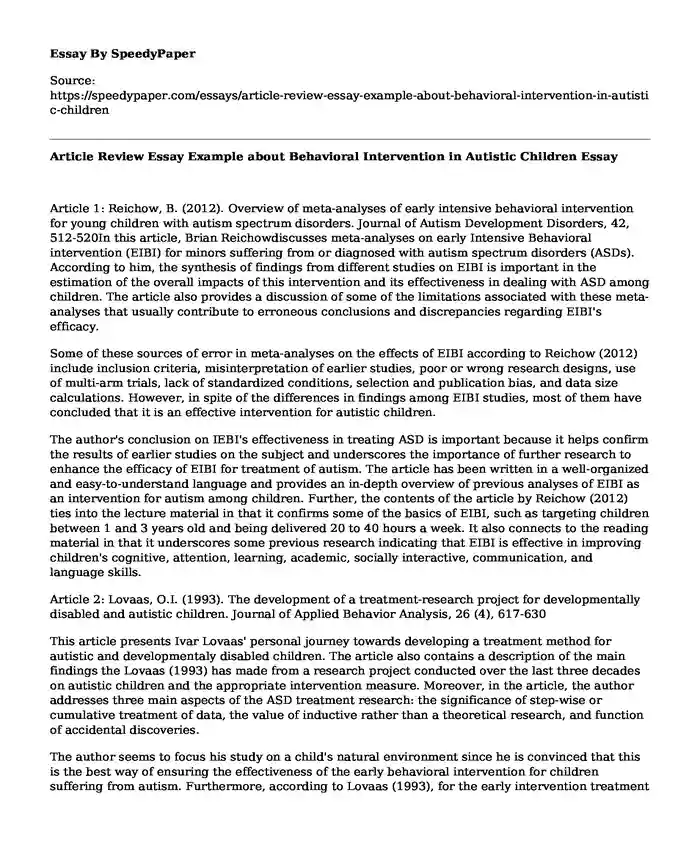Article 1: Reichow, B. (2012). Overview of meta-analyses of early intensive behavioral intervention for young children with autism spectrum disorders. Journal of Autism Development Disorders, 42, 512-520In this article, Brian Reichowdiscusses meta-analyses on early Intensive Behavioral intervention (EIBI) for minors suffering from or diagnosed with autism spectrum disorders (ASDs). According to him, the synthesis of findings from different studies on EIBI is important in the estimation of the overall impacts of this intervention and its effectiveness in dealing with ASD among children. The article also provides a discussion of some of the limitations associated with these meta-analyses that usually contribute to erroneous conclusions and discrepancies regarding EIBI's efficacy.
Some of these sources of error in meta-analyses on the effects of EIBI according to Reichow (2012) include inclusion criteria, misinterpretation of earlier studies, poor or wrong research designs, use of multi-arm trials, lack of standardized conditions, selection and publication bias, and data size calculations. However, in spite of the differences in findings among EIBI studies, most of them have concluded that it is an effective intervention for autistic children.
The author's conclusion on IEBI's effectiveness in treating ASD is important because it helps confirm the results of earlier studies on the subject and underscores the importance of further research to enhance the efficacy of EIBI for treatment of autism. The article has been written in a well-organized and easy-to-understand language and provides an in-depth overview of previous analyses of EIBI as an intervention for autism among children. Further, the contents of the article by Reichow (2012) ties into the lecture material in that it confirms some of the basics of EIBI, such as targeting children between 1 and 3 years old and being delivered 20 to 40 hours a week. It also connects to the reading material in that it underscores some previous research indicating that EIBI is effective in improving children's cognitive, attention, learning, academic, socially interactive, communication, and language skills.
Article 2: Lovaas, O.I. (1993). The development of a treatment-research project for developmentally disabled and autistic children. Journal of Applied Behavior Analysis, 26 (4), 617-630
This article presents Ivar Lovaas' personal journey towards developing a treatment method for autistic and developmentaly disabled children. The article also contains a description of the main findings the Lovaas (1993) has made from a research project conducted over the last three decades on autistic children and the appropriate intervention measure. Moreover, in the article, the author addresses three main aspects of the ASD treatment research: the significance of step-wise or cumulative treatment of data, the value of inductive rather than a theoretical research, and function of accidental discoveries.
The author seems to focus his study on a child's natural environment since he is convinced that this is the best way of ensuring the effectiveness of the early behavioral intervention for children suffering from autism. Furthermore, according to Lovaas (1993), for the early intervention treatment to be effective in treating severe behavioral disorders, it should be conducted during the early waking hours of a child.
The significance of this article in the context of IEBI is that it helps the reader to understand how the concept of early intensive behavioral treatment came into being and what factors drove early researchers like Lovaas (1993) to be interested in helping autistic children. From the article, one can easily decipher the social context in which research on EIBI's efficacy first started and the future of EIBI in addressing the problem of ASD in children.
This article's content ties into the lecture material in that it emphasizes and restates the basic idea that EIBI only works best in the early stages of a child's development; that is, when they are between 2 and 3 years of age. It also ties into the lecture material in that it shows that EIBI was originally developed By Ivar Lovaas at UCLA, requires between 30 to 40 hours per week, and makes use of task analyses, generalization training, reinforcements, and discrete trial training.
References
Reichow, B. (2012). Overview of meta-analyses of early intensive behavioral intervention for young children with autism spectrum disorders. Journal of Autism DevelopmentDisorders, 42, 512-520
Lovaas, O.I. (1993). The development of a treatment-research project for developmentally-disabled and autistic children. Journal of Applied Behavior Analysis, 26 (4), 617-630
Cite this page
Article Review Essay Example about Behavioral Intervention in Autistic Children. (2022, Apr 13). Retrieved from https://speedypaper.net/essays/article-review-essay-example-about-behavioral-intervention-in-autistic-children
Request Removal
If you are the original author of this essay and no longer wish to have it published on the SpeedyPaper website, please click below to request its removal:
- Free Essay with a Discussion Post on Mass Fatality Iincidents
- Land as a Major Theme during American Colonial Period. Free Essay.
- Free Essay Example about Zoos and Their Role
- Christopher Columbus: Extracts from Journal. Free Essay Sample
- Decolonization: Last Shall Be First in the Liberation Process
- Youth in Criminal Justice
- Benefits of Psychoanalysis in Patients With Phobias and Anxiety Disorders - Free Essay
Popular categories





